
The Couque de Dinant (English: Cake of Dinant) is an extremely hard, sweet biscuit native to the southern Belgian city of Dinant in Wallonia.

The Couque de Dinant (English: Cake of Dinant) is an extremely hard, sweet biscuit native to the southern Belgian city of Dinant in Wallonia.
Couques are made with only two ingredients: wheat flour and honey, in equal amounts by weight, and nothing else at all: not even water or yeast. The dough is put in a wooden mould made from wood from the pear tree, walnut tree or beech tree. The moulds have a wide variety of shapes, which include animals, floral motifs, people or landscapes.
The biscuit is cooked in an oven preheated to around 300 °C (575 °F) for 15 minutes, which allows the honey to caramelize. On cooling, the biscuit becomes very hard, and can be preserved indefinitely. Due to this property, couques can be displayed as decoration, used as Christmas tree ornaments, or used to commemorate special occasions. [1] [2]
A variant, the couque de Rins also adds sugar to the dough. [1] It is sweeter and softer as a result.

Due to their extreme hardness and fairly large size, couques de Dinant are not intended to be bitten into directly. They are instead broken into fragments and can then be bitten, sucked, left to melt in the mouth or be soaked in coffee. Couques de Dinant have been traditionally given to babies during teething. [3]
While Dinant bakeries see large sales over the summer season due to tourists, consumption of couques is highest near Saint Nicholas Day in December. At that time of year, they are sold and eaten all over Belgium. [1]
A popular though unlikely legend holds that the couques arose from the sacking of Dinant in 1466 by Charles the Bold in the Liège Wars. The citizens were supposedly desperate and had little to eat but flour and honey, so they conceived of making a dough out of the two mixed together. As the dough was so firm, they had the idea of printing it in the negative in dinanderie (local ornate brasswork), and thereby began the tradition of giving them patterns. [1]
Much more certain is that the couque began to appear some time in the 18th century, though the exact circumstances of its invention are unclear. [1]
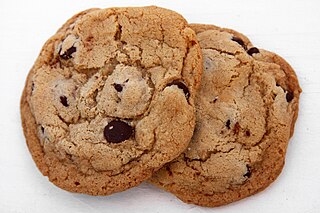
A cookie or biscuit is a baked snack or dessert that is typically small, flat, and sweet. It usually contains flour, sugar, egg, and some type of oil, fat, or butter. It may include other ingredients such as raisins, oats, chocolate chips, or nuts.
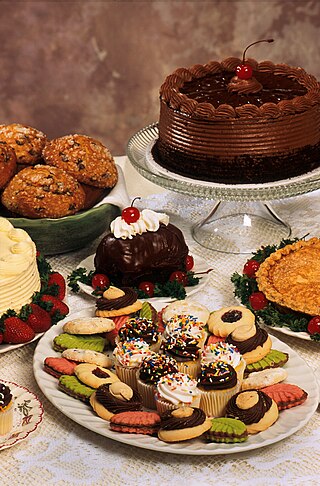
Dessert is a course that concludes a meal. The course consists of sweet foods, such as cake, biscuit, ice cream and possibly a beverage such as dessert wine and liqueur. Some cultures sweeten foods that are more commonly savory to create desserts. In some parts of the world there is no tradition of a dessert course to conclude a meal.

Confectionery is the art of making confections, or sweet foods. Confections are items that are rich in sugar and carbohydrates although exact definitions are difficult. In general, however, confections are divided into two broad and somewhat overlapping categories: bakers' confections and sugar confections.

Pastry refers to a variety of doughs, as well as the sweet and savoury baked goods made from them. These goods are often called pastries as a synecdoche, and the dough may be accordingly called pastry dough for clarity. Sweetened pastries are often described as bakers' confectionery. Common pastry dishes include pies, tarts, quiches, croissants, and pasties.

A doughnut or donut is a type of pastry made from leavened fried dough. It is popular in many countries and is prepared in various forms as a sweet snack that can be homemade or purchased in bakeries, supermarkets, food stalls, and franchised specialty vendors. Doughnut is the traditional spelling, while donut is the simplified version; the terms are used interchangeably.

A biscuit, in many English-speaking countries, including Britain, Ireland, Australia, New Zealand, India, and South Africa but not Canada or the US, is a flour-based baked and shaped food item. Biscuits are typically hard, flat, and unleavened. They are usually sweet and may be made with sugar, chocolate, icing, jam, ginger, or cinnamon. They can also be savoury, similar to crackers. Types of biscuit include biscotti, sandwich biscuits, digestive biscuits, ginger biscuits, shortbread biscuits, chocolate chip cookies, chocolate-coated marshmallow treats, Anzac biscuits, and speculaas.

Lebkuchen, Honigkuchen or Pfefferkuchen are honey-sweetened German cakes, moulded cookies or bar cookies that have become part of Germany's Christmas traditions. They are similar to gingerbread.

Gingerbread refers to a broad category of baked goods, typically flavored with ginger, cloves, nutmeg, and cinnamon and sweetened with honey, sugar, or molasses. Gingerbread foods vary, ranging from a moist loaf cake to forms nearly as crisp as a ginger snap.
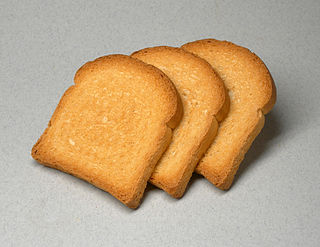
A rusk is a hard, dry biscuit or a twice-baked bread. It is sometimes used as a teether for babies. In some cultures, rusk is made of cake, rather than bread: this is sometimes referred to as cake rusk. In the UK, the name also refers to a wheat-based food additive.

Czech cuisine has both influenced and been influenced by the cuisines of surrounding countries and nations. Many of the cakes and pastries that are popular in Central Europe originated within the Czech lands. Contemporary Czech cuisine is more meat-based than in previous periods; the current abundance of farmable meat has enriched its presence in regional cuisine. Traditionally, meat has been reserved for once-weekly consumption, typically on weekends.
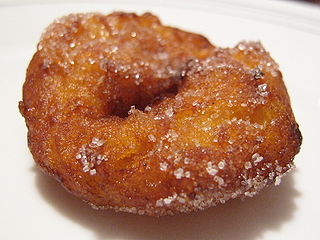
A buñuelo (Spanish:[buˈɲwelo], alternatively called boñuelo, bimuelo, birmuelo, bermuelo, bumuelo, burmuelo, or bonuelo, is a fried dough fritter found in Spain, Latin America, and other regions with a historical connection to Spaniards, including Southwest Europe, the Balkans, Anatolia, and other parts of Asia and North Africa. Buñuelos are traditionally prepared at Christmas. It will usually have a filling or a topping. In Mexican cuisine, it is often served with a syrup made with piloncillo.

Pain d'épices or pain d'épice is a French cake or quick bread. Its ingredients, according to Le Dictionnaire de l'Académie française (1694), were "rye flour, honey and spices". In Alsace, a considerable tradition incorporates a pinch of cinnamon.
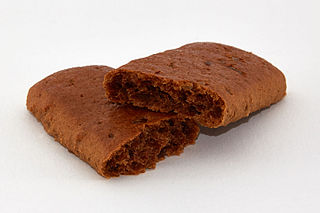
Aachener Printen are a type of Lebkuchen originating from the city of Aachen in Germany. Somewhat similar to gingerbread, they were originally sweetened with honey, but are now generally sweetened with a syrup made from sugar beets.